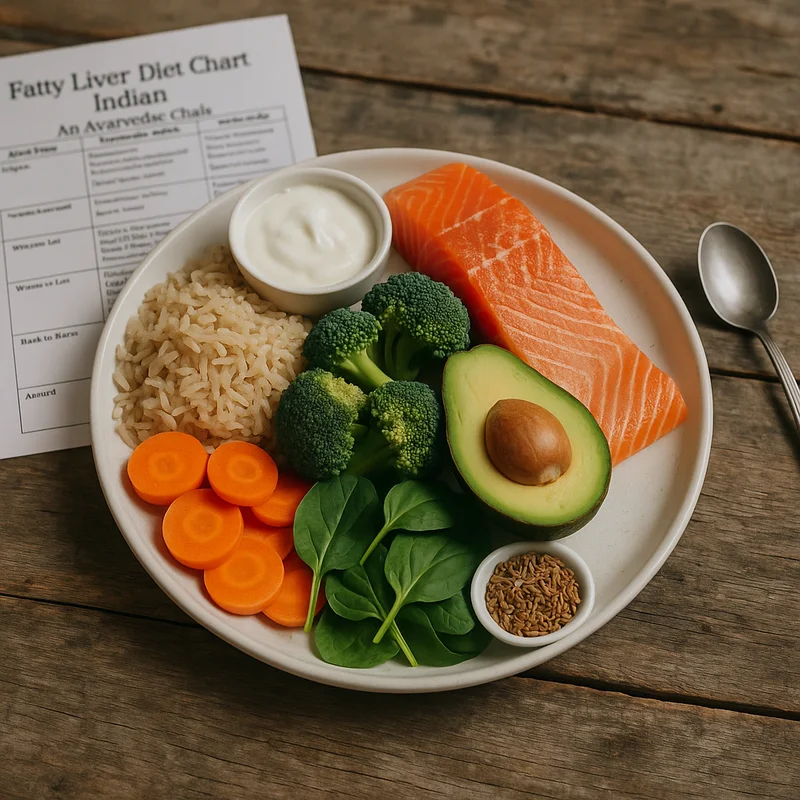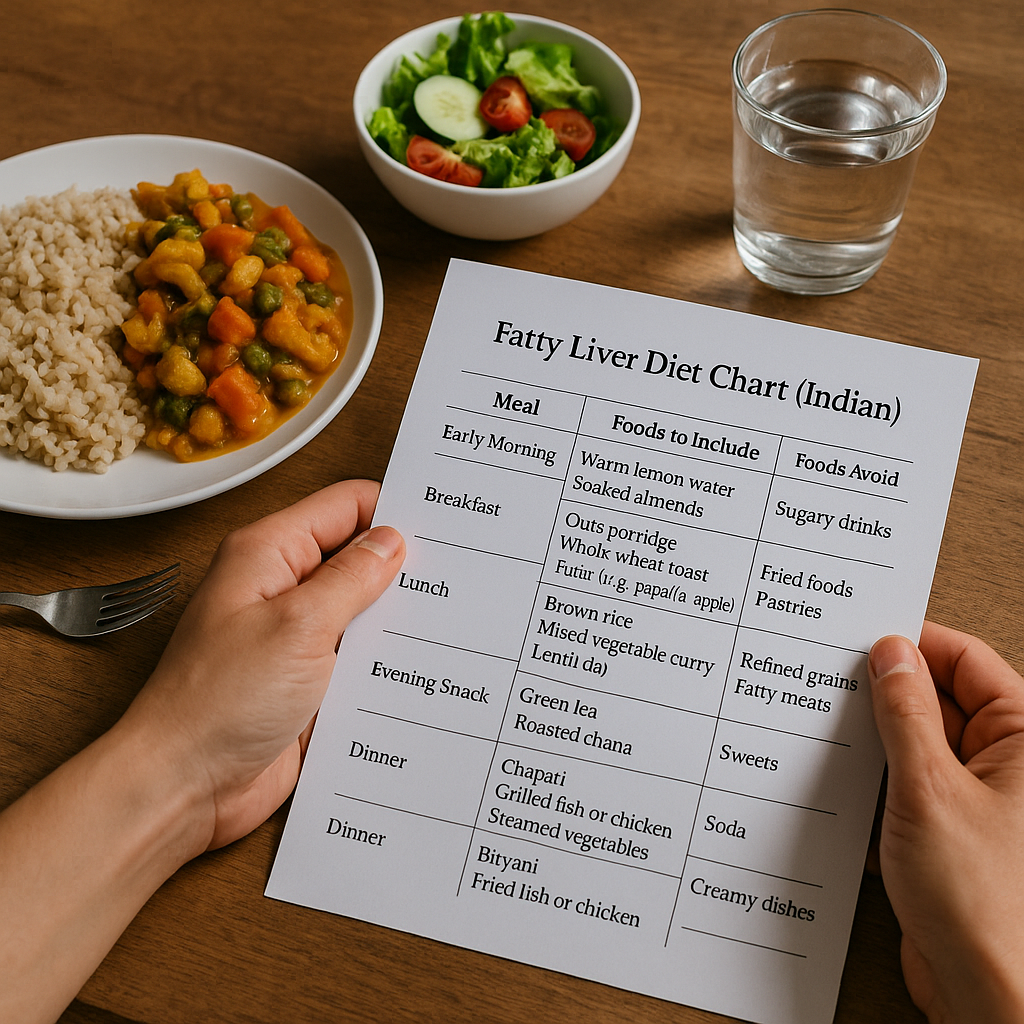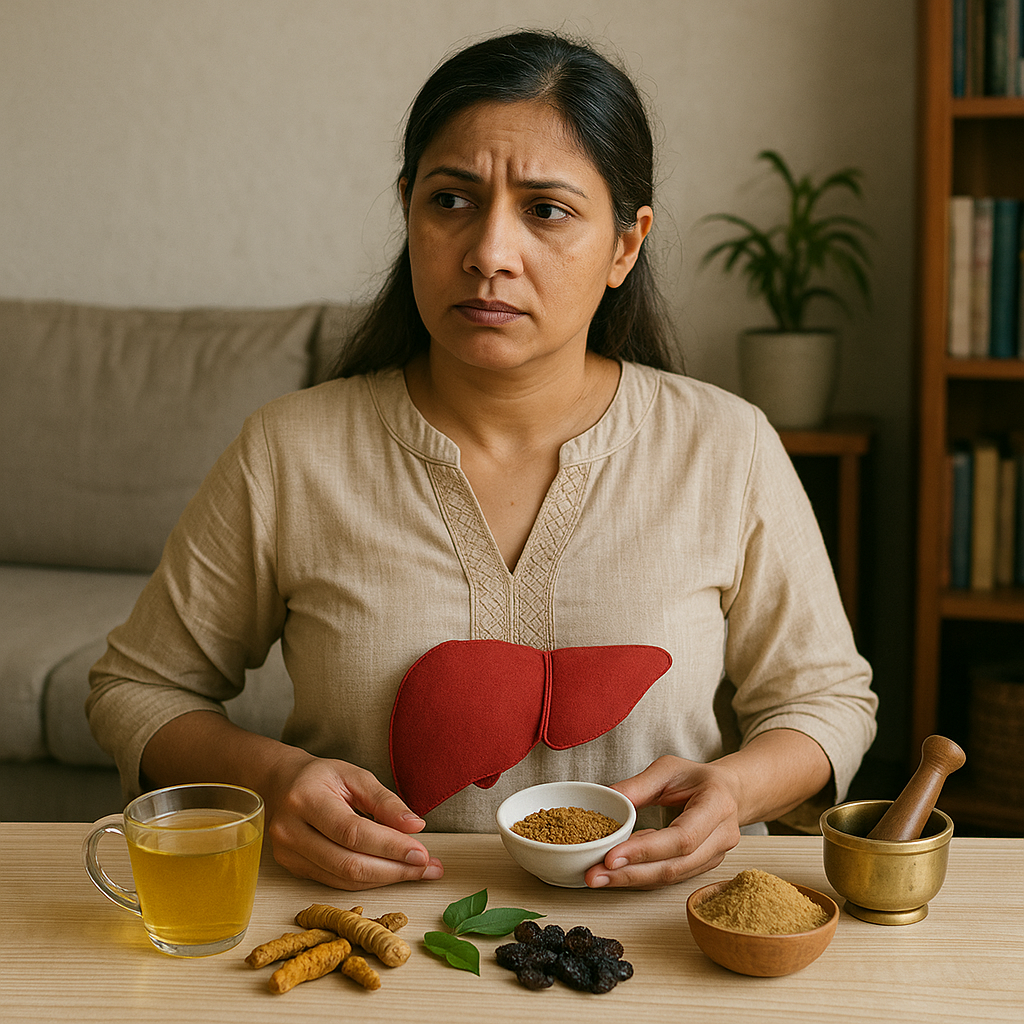Ask Ayurvedic doctor a question and get a consultation online on the problem of your concern in a free or paid mode. More than 2,000 experienced doctors work and wait for your questions on our site and help users to solve their health problems every day.
Shop Now in Our Store
Fatty Liver Diet Chart Indian: An Ayurvedic Take on What to Eat, When, and Why It Matters

Introduction to Fatty Liver Diet Chart Indian and Ayurveda’s Approach
Let’s not sugarcoat this (and I mean that literally): fatty liver is becoming ridiculously common — and yes, especially in India. You might’ve heard your uncle casually mention his liver “getting fatty” while polishing off a third helping of butter-laden paratha. Or maybe your doctor just dropped the news after a routine checkup — “Your liver enzymes are a bit high. Might be a fatty liver.” That phrase hits harder than expected, right?
So what now?
Jump straight into a fat-free, protein-packed modern diet? Maybe. But if you’re someone who feels a little disconnected from clinical charts and calorie-counting apps — or if you've ever been drawn to the gentle rhythms of Ayurveda — then you might want to take a pause.
Because Ayurvedic wisdom has a different voice. It doesn’t yell “eliminate all oil!” or throw strange powders at you. It listens. Observes. Adapts.
See, fatty liver (or Non-Alcoholic Fatty Liver Disease — NAFLD, to be fancy) isn’t just about fat. It’s about digestion, metabolism, your agni (digestive fire), the doshas (Vata, Pitta, Kapha) going out of balance, and yes, even your emotional state. Ayurveda doesn’t treat the liver in isolation. It treats you — the whole person.
This guide isn’t just a list of what to eat and avoid. It’s a dive into how you live, think, move, and yes — how you digest life, not just food. Expect more than a diet chart. Expect a journey. And sure, while we’ll get to the part where we suggest things like methi water or triphala, the point is deeper.
By the time you finish this (yes, it’s long, but worth it), you’ll understand:
-
Why how you eat is sometimes more important than what you eat.
-
Which foods your liver actually loves (hint: they’ve been in your kitchen all along).
-
Why stress and irregular sleep can be just as harmful to your liver as deep-fried samosas.
-
And how small, consistent Ayurvedic tweaks can bring you lasting change — even if you’re not into chanting or turmeric lattes.
Ready? Let’s make this real, relatable, and rooted in wisdom. One bite at a time.

Understanding the Role of Ayurveda in Managing Fatty Liver Diet Chart Indian
What Ayurveda Says About Fatty Liver
In Ayurvedic terms, fatty liver isn’t labeled the same way modern medicine does. There's no term like “Grade 2 NAFLD” floating around ancient texts. But the symptomatology? Oh yes — it's all there.
Fatty liver is generally seen as a result of Kapha and Pitta imbalance, where the liver's natural ability to transform and metabolize gets sluggish. In Ayurveda, the liver is closely connected to the Ranjaka Pitta subtype — the one responsible for bile production, blood health, and metabolic fire. When this goes off-track, fat accumulates, digestion becomes weak, and toxins (ama) start collecting.
Sometimes I wonder — how did they know all this, centuries before liver function tests were a thing?
Ayurvedic practitioners talk about conditions like Yakrit Roga (liver disorders) and Medoroga (disorders related to fat metabolism) — both of which often align with what modern medicine now calls fatty liver. The cause? Overeating, especially heavy, oily, sweet, or processed foods. Add sedentary lifestyle, irregular sleep, and unchecked stress — and voilà: a classic case of fatty liver, Ayurveda-style.
How Ayurvedic Lifestyle & Diet Directly Impact Fatty Liver
Let’s keep this simple. Ayurveda believes digestion is the cornerstone of all health. If digestion falters, the body doesn’t get nourished properly, toxins accumulate, and diseases — like fatty liver — set in.
So instead of just recommending a bunch of “don’ts,” Ayurveda focuses on building back that inner digestive strength. That’s why you’ll often hear about:
-
Triphala to cleanse.
-
Guduchi (Giloy) for rejuvenation.
-
Punarnava to reduce inflammation and water retention.
-
Kutki (not widely known, but amazing for liver detox).
But again — it’s not about pills or powders alone. You’ll be asked to eat lighter at night. To sip warm water instead of gulping iced colas. To eat mindfully. These seem like small things — but trust me, they build up. Ayurveda is a long game. It doesn't shout. It whispers until it rewires you.
The Importance of Individualized Ayurvedic Approaches for Fatty Liver
Okay, here’s something people often miss. Ayurveda is never one-size-fits-all.
Yes, this guide offers general recommendations — but your body? Your constitution? Your prakriti? All that matters. Some people have a Kapha-dominant body — naturally slower metabolism, tendency to gain weight, love for sweets. Others may have Pitta dominance — prone to inflammation, acidity, maybe even angry outbursts (don’t worry, it’s not just you).
So a Kapha-predominant person with fatty liver may need a more stimulating, lighter diet — bitter vegetables, pungent spices, more activity. A Pitta person might benefit from cooling herbs, more calming routines, and stress-reduction. And a Vata individual? Well, if they happen to have fatty liver, it’s likely due to a deeper metabolic disconnect and may need grounding, nourishing care.
Bottom line? Ayurveda sees you before it sees your “disease.” That’s why this guide offers insights — but a consultation with an experienced Ayurvedic doctor can take your healing to a deeper, tailored level.
Ayurvedic Dietary Guidelines for Fatty Liver Diet Chart Indian
So let’s talk food — because come on, that’s what most people want first, right?
But before I toss out a bunch of food names like a WhatsApp forward, let’s ground this in something deeper. Ayurveda doesn’t just say “eat this, not that.” It asks: What suits your dosha? What season is it? How’s your digestion today? It’s more intuitive than mechanical.
And when it comes to fatty liver? It’s all about rekindling agni — that digestive fire — without overwhelming your system.
Foods Recommended by Ayurveda for Fatty Liver Diet Chart Indian
Here’s the stuff your liver would probably swipe right on:
-
Bitter vegetables — Think karela (bitter gourd), methi (fenugreek), and neem leaves. Not everyone’s favorite, but these guys scrape toxins and balance Kapha-Pitta.
-
Old grains — Rice that’s aged for a year or more is lighter and easier to digest. Try red rice or hand-pounded rice in small amounts.
-
Green moong dal — Light, easy on the liver, and packed with protein.
-
Lauki (bottle gourd), torai (ridge gourd), and pumpkin — These watery veggies are soothing and help in detox.
-
Spices like turmeric, black pepper, cumin, ajwain, ginger — Not just for flavor. These rev up digestion and help melt metabolic residue.
-
Warm water — I know, it’s boring. But sipping warm water through the day works like a gentle inner cleanse.
And yes — fruits! But go for those with low glycemic index: apple, guava, papaya, pomegranate. Not banana milkshakes, please.
Foods Ayurveda Suggests Avoiding for Fatty Liver Diet Chart Indian
This might hurt a little — but worth it:
-
Dairy overload — Especially curd, paneer, and cold milk. They’re heavy and mucus-forming.
-
Excess wheat or maida — Stick to lighter grains. Roti with ghee isn’t a sin, but balance is key.
-
Fried foods — Samosas, pakoras, chips. Do I really need to explain?
-
Heavy meats — Red meat, mutton, processed meats are tough to digest.
-
Sugar and jaggery in excess — Even Ayurveda doesn’t give sugar a free pass.
-
Cold drinks and ice water — These literally put out your digestive fire.
Sometimes, it's not even about what you eat, but how consistently you eat junk. You don't need to swear off pizza forever — just don’t make it your Thursday ritual.
Meal Planning and Timing Tips in Ayurveda for Fatty Liver Diet Chart Indian
This one’s simple, but powerful:
-
Breakfast should be light and warming — think moong dal chilla, or upma with ghee.
-
Lunch is your main meal. Ideally between 12–1:30 pm. Your agni’s at its peak.
-
Dinner should be early (ideally before 8 pm) and light — soup, khichdi, or cooked veggies.
No midnight snacking. No 10 pm biryanis. Sorry, but your liver’s on night shift.
Bonus tip? Try eating in silence. Without scrolling. Ayurveda says your mind digests food too.
Hydration and Beverage Recommendations for Fatty Liver Diet Chart Indian
Skip the smoothies and cold shakes. Instead:
-
Warm jeera water
-
Methi seed water (soaked overnight, strained, drunk on empty stomach)
-
Herbal teas — tulsi, ginger, fennel
-
Aloe vera juice (unsweetened, in moderation)
-
And my favorite — a dash of lemon in warm water after meals
Caffeine? You can keep your one chai — just not ten.
Ayurvedic Lifestyle Practices Specifically Beneficial for Fatty Liver Diet Chart Indian
This isn’t just about food. Ayurveda is a full-spectrum system — it’s in how you wake up, sleep, breathe, and even poop.
Daily Ayurvedic Routines (Dinacharya) to Manage Fatty Liver
Start small. Try this flow:
-
Wake up by 6:30 AM (or earlier, if you’re a superhero).
-
Oil pulling — 1 tsp sesame oil in the mouth, swish and spit. Great for detox.
-
Warm water first thing — with lemon or soaked fenugreek if possible.
-
Bowel routine — Consistency matters more than perfection.
-
Dry body brushing or Abhyanga (oil massage) — boosts lymphatic drainage and circulation.
-
Light exercise or yoga (we’ll get to that soon).
-
Eat your meals at fixed times, and avoid post-meal naps.
Sleep Patterns and Ayurvedic Guidelines Relevant to Fatty Liver
Late-night Netflix isn’t doing your liver any favors.
-
Try to sleep by 10:30 PM — Pitta hours (10 pm–2 am) are when your liver does its repair work.
-
Avoid late-night snacking or scrolling. Blue light is the new junk food.
-
If digestion is sluggish, try ½ tsp of triphala powder with warm water before bed.
Ayurvedic Personal Care Practices for Fatty Liver
-
Copper vessel water — Store water in copper overnight, drink it in the morning.
-
Dry brushing with a natural bristle brush before bath — helps circulation.
-
Self-massage with warm sesame or castor oil once or twice a week — especially for Kapha types.
-
Triphala eyewash or nasya (oil in nostrils) can help balance overall doshas.
Little rituals, big shifts.

Yoga & Breathing Techniques for Fatty Liver Diet Chart Indian
The liver, in Ayurveda, isn’t just a physical organ. It’s tied to anger, frustration, and suppressed emotions. Movement — especially mindful movement — helps unlock that.
Yoga Asanas Specifically Recommended for Fatty Liver Diet Chart Indian
Start gentle. Here are some postures your liver will love:
-
Bhujangasana (Cobra Pose) — Stimulates abdominal organs.
-
Dhanurasana (Bow Pose) — Strengthens core, massages liver.
-
Paschimottanasana (Seated Forward Bend) — Calms the nervous system.
-
Ardha Matsyendrasana (Spinal Twist) — Supports detoxification.
-
Surya Namaskar (Sun Salutation) — Great overall, but don’t overdo it if Pitta is high.
Hold poses gently. Focus more on breathing than stretching like a gymnast.
Pranayama (Breathing Exercises) That Improve Fatty Liver
This stuff works. You just have to do it.
-
Anulom Vilom (Alternate Nostril Breathing) — Balances all doshas, especially good for stress.
-
Bhramari (Bee Breathing) — Calms the liver's "fiery" nature.
-
Kapalabhati — Powerful, but use caution; not for everyone. Best with guidance.
Ten minutes daily. That’s it. Your liver will literally breathe easier.
How Often to Practice Yoga & Breathing Techniques for Fatty Liver
-
Yoga: 20–30 minutes, 5 times a week is ideal.
-
Breathwork (Pranayama): 10–15 minutes, daily.
-
Consistency trumps intensity. You don’t need to become a yoga teacher. Just move, breathe, and be present.
Stress Management and Emotional Health Advice for Fatty Liver Diet Chart Indian
Yeah, yeah — stress is bad for everything. But here’s the thing: your liver literally feels it.
In Ayurveda, unprocessed emotions are as real as unprocessed fats. And both get stuck in the liver.
Ayurvedic Techniques to Reduce Stress Related to Fatty Liver
-
Shirodhara — Oil poured on the forehead. Sounds odd, feels heavenly.
-
Brahmi and Ashwagandha — Herbs that soothe the nervous system.
-
Nasya with calming oils — Just 2 drops of Anu Taila in nostrils.
If you’re not ready for oils and therapies, just unplug your phone for 2 hours a day. That’s a good start.
Meditation and Mindfulness Practices Beneficial for Fatty Liver
-
Guided meditation works if you're new. Apps are okay.
-
Even 5 minutes of silence post-lunch can help digestion.
-
Walking in nature — Ayurveda’s original prescription.
Sometimes I just sit on the balcony, close my eyes, and listen. No agenda. That’s meditation too.
Emotional and Psychological Considerations in Ayurveda for Fatty Liver
-
Suppressed anger, unresolved grief, burnout — they all pile up in the liver.
-
Ayurveda says emotions are digestive too. If you don’t process them, they turn into toxins.
-
Journaling, talking to someone, counseling — it’s not un-Ayurvedic. It’s healing.
Practical Ayurvedic Home Remedies and Recipes for Fatty Liver Diet Chart Indian
This is the part where things start getting hands-on — and honestly, a little fun. Because there’s something oddly satisfying about whipping up a bitter decoction that your grandma would nod approvingly at.
But remember — these remedies aren’t quick-fix magic bullets. They’re support systems. Consistency over drama.
Simple and Effective Home Remedies for Fatty Liver
-
Triphala Water
Soak ½ tsp of Triphala powder in warm water overnight. Drink in the morning on an empty stomach.
Helps cleanse the liver and bowels gently. -
Methi Water
Soak 1 tsp of fenugreek seeds in a glass of water overnight. Strain and sip in the morning.
Balances blood sugar, reduces insulin resistance — a hidden fatty liver culprit. -
Amla Juice or Raw Amla
One raw amla or 10–15 ml fresh juice in the morning.
Potent antioxidant. Strengthens digestion and liver cells. -
Guduchi Decoction
Boil 1 tsp dried Guduchi in 2 cups of water, reduce to half, sip warm.
Detoxifying, anti-inflammatory, liver-protective. -
Castor Oil Pack
Old-school, but powerful. Soak a cloth in warm castor oil, place it over the liver area, cover with plastic, and apply heat for 20–30 minutes.
Supports lymphatic flow and liver detox.
Don’t mix too many remedies. Pick one or two that suit your schedule and stick with them for a month. Watch how your body responds.
Ayurvedic Recipe Ideas Specifically Beneficial for Fatty Liver
Let’s not pretend you’ll live off boiled lauki forever. Here are some real Indian meals that your liver and your tongue will both enjoy:
-
Moong Dal Khichdi with Ghee and Ajwain
Light, easy to digest, warming. Add grated bottle gourd for extra liver love. -
Bitter Gourd & Tomato Curry
Sounds harsh? Cooked right, it’s oddly addictive. The bitterness actually balances Kapha-Pitta excesses. -
Steamed Veg + Tadka Rice Combo
Steamed lauki, beans, and carrots with rice and a spice-rich tadka of cumin, ginger, turmeric. -
Coriander-Mint Buttermilk
Blend thin buttermilk with roasted jeera, mint, coriander, and pink salt. Mid-day liver cooler. -
Carrot-Beet Soup with Hing and Garlic
Slightly sweet, grounding, and liver-friendly.
Preparation Tips and Guidelines for Ayurvedic Remedies
-
Always use warm or hot water — not cold — for decoctions.
-
Avoid adding sugar, jaggery, or milk to herbal remedies.
-
Prepare remedies fresh whenever possible.
-
Use iron or clay cookware when practical — they add trace nutrients.
-
Observe your body: bloating, fatigue, or any odd reaction? Take a break.
Ayurveda teaches you to watch yourself. That’s the first medicine.

Common Mistakes & Misconceptions About Ayurvedic Lifestyle for Fatty Liver
Ayurveda’s trending. Great. But trends often warp the original meaning.
Let’s clear the air.
Common Myths About Ayurveda & Fatty Liver
-
“Ayurveda is slow.”
Not true. It's steady. The changes may not be overnight, but they’re often deeper and more lasting. -
“You have to give up all modern food.”
Nah. Ayurveda encourages awareness, not fear. A slice of cake isn’t forbidden — unconscious overeating is. -
“Ayurvedic remedies are harmless, so you can DIY everything.”
Danger zone. Herbs are powerful — and context matters. Kutki, for example, is liver-friendly but not for pregnant women. -
“Only vegetarians can follow Ayurveda.”
Not really. Ayurveda works with what's appropriate for your prakriti, lifestyle, and even desh (climate).
Typical Mistakes People Make When Adopting Ayurvedic Lifestyle for Fatty Liver
-
Chugging bitter herbs while still eating processed junk.
-
Overdoing detox — leading to fatigue, dehydration, or mood swings.
-
Mixing too many herbs at once.
-
Expecting liver enzymes to drop without changing sleep or stress patterns.
-
Ignoring prakriti — the baseline constitution.
How to Avoid These Mistakes
-
Start small. One meal change, one daily herb, one 10-minute walk.
-
Consult an Ayurvedic doctor — even once — for a custom plan.
-
Listen to your gut — literally and emotionally. Ayurveda starts with self-awareness.
Real-Life Success Stories & Testimonials Related to Fatty Liver Diet Chart Indian
Nothing hits home like a real story. Here are two (slightly fictionalized, but very real-feeling) ones:
Inspirational Stories from Individuals Who Improved Fatty Liver Through Ayurvedic Lifestyle
Ravi, 38, Gurgaon
After his Grade 2 fatty liver diagnosis, Ravi tried keto and HIIT — and crashed hard. “I felt like I was forcing change,” he said. A cousin nudged him toward Ayurveda. Within 3 months of simple diet tweaks, daily ginger tea, and guided yoga, his digestion improved and his ultrasound showed fatty deposits reducing. “I still eat pizza occasionally. But now, I know how to come back to balance.”
Sonal, 45, Pune
Always tired. Bloated. Angry. Her doctor called it early-stage NAFLD. Ayurveda called it a Kapha-Pitta flare-up. With bitter veggie soups, 15 minutes of Pranayama, and early dinners, her energy returned. “Honestly, the emotional shift was the biggest thing. I stopped being so harsh on myself.”
Real-world Benefits & Results Achieved Using Ayurvedic Recommendations for Fatty Liver
-
Reduced liver enzyme levels (SGPT, SGOT) within 3–6 months
-
Weight loss without drastic dieting
-
Improved energy, better sleep, and regulated digestion
-
Reduced cravings for junk food
-
Greater emotional resilience
Scientific Evidence Supporting Ayurvedic Lifestyle & Diet for Fatty Liver
We’re living in the evidence age. Good news — Ayurveda’s catching up in journals too.
Research Findings About Diet’s Impact on Fatty Liver
Modern science confirms:
-
Low GI, whole food diets reduce liver fat
-
Intermittent fasting and circadian eating improve liver function
-
Bitter foods help regulate bile secretion
Ayurveda’s been saying this for 5,000 years. The language is different — the truth overlaps.
Clinical Studies Confirming the Benefits of Ayurvedic Practices for Fatty Liver
-
A 2022 study in the Journal of Ayurveda and Integrative Medicine showed that Triphala reduced liver enzymes and oxidative stress markers in NAFLD patients.
-
Kutki (Picrorhiza kurroa) has shown hepatoprotective effects in multiple animal and human trials.
-
Yoga-based lifestyle interventions, including asanas and pranayama, improved fatty liver grades significantly over 12 weeks in a 2021 AIIMS study.
Expert Opinions on Ayurvedic Approaches to Fatty Liver
Dr. P. Ram Manohar (Ayurveda researcher) notes, “Ayurveda offers a systems approach — it doesn't just reduce fat; it restores metabolic rhythm.”
Dr. Sujata Kelkar Shetty, author and wellness consultant, says, “Ayurveda’s not soft science. It’s just subtle — and it works when aligned with modern awareness.”
Conclusion & Summary of Ayurvedic Recommendations for Fatty Liver Diet Chart Indian
We’ve covered a lot. So let’s distill it down.
Key Takeaways:
-
Fatty liver isn’t just about fat. It’s about how you digest — food, emotions, time.
-
Ayurveda treats the root. Not just symptoms. It brings your whole system back to sync.
-
Food is your first medicine. Especially bitter, warm, light, and seasonal.
-
Routines matter. Wake early, eat at the right time, sleep early, breathe consciously.
-
Mind and mood affect your liver. Relax, reflect, express.
This isn’t a 7-day cleanse. It’s a new rhythm. One that feels like home.
Call to Action
If you’re serious about healing — or even just curious — don’t guess alone.
Get personalized Ayurvedic consultation for fatty liver today.
Let an expert look at your dosha, your patterns, and your lifestyle.
Because you’re not a textbook. You’re a living, breathing, complex human being.
And Ayurveda gets that.
Frequently Asked Questions (FAQ) about Ayurvedic Lifestyle for Fatty Liver Diet Chart Indian
1. Can Ayurveda completely cure fatty liver?
Ayurveda doesn’t use the word “cure” casually. But yes — many have reversed fatty liver naturally using Ayurvedic routines, herbs, and diet. Consistency is key.
2. Is Triphala safe to take daily for fatty liver?
Generally yes, especially in small doses like ½ tsp at night. But avoid if you have diarrhea, are pregnant, or under 12. Always consult an Ayurvedic practitioner.
3. Are dairy products completely banned in Ayurveda for fatty liver?
Not completely. Warm milk with turmeric or small amounts of ghee are often beneficial. Cold milk, curd, and paneer are generally avoided.
4. How long does it take for Ayurveda to show results in fatty liver?
It varies. Some see improvements in 4 weeks; for others, it takes 3–6 months. Your constitution, stage of fatty liver, and how disciplined you are all matter.
5. Can I follow both modern medicine and Ayurveda for fatty liver?
Absolutely. Ayurveda can complement modern medicine beautifully. Just share all supplements and medicines with both your doctors for safety.
This article is checked by the current qualified Dr Sujal Patil and can be considered a reliable source of information for users of the site.

